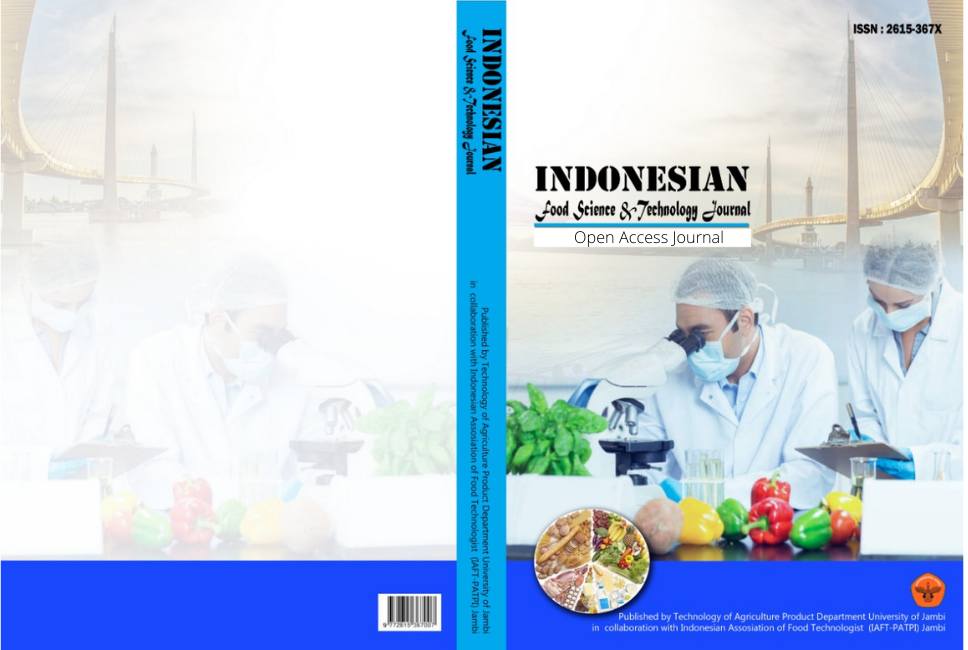Changes in Lactic Acid Bacteria and Quality of Gac Yoghurt Supplemented with Carbohydrate Sources during Chilled Storage
DOI:
https://doi.org/10.22437/ifstj.v6i1.19132Keywords:
yoghurt, gac fruit, lactic acid bacteria, inulin, natural sweetenersAbstract
Gac yoghurt is formulated by mixing gac juice with cow milk and probiotics to form a thick yellow fluid. The research objective was to study the effect of carbohydrate sources (inulin, honey, sucrose, fruit syrup, and sucrose) on lactic acid bacteria remaining after the chilled storage for 28 days. The gac yoghurt was analyzed with physicochemical and sensory characteristics. The experimental design was a Complete Randomized Design (CRD) with eight parameters (total soluble solids, pH, lactic acid content, syneresis, texture, colour, lactic acid bacteria survival, and sensory evaluation). The results showed that in the presence of honey, gac yoghurt had a higher lactic acid count than other treatments throughout 28 days of storage. The lactic acid growth was observed in the first two weeks, then it was almost constant in the third week and levelled off at the end of storage. The addition of carbohydrates resulted in a lower pH than a control. It increased total soluble solids, titratable acidity, and syneresis effect. Gac yoghurt with inulin enrichment kept for 28 days showed a firmer texture and lighter than the rest. However, sensory results showed that gac yoghurt with sucrose was the most preferred formulae based on the average Hedonic scores followed by the yoghurt fermented with honey, inulin, and fruit syrup, respectively.
Downloads
References
Puteri, N. E., Pratama, F., and Anantawat, V. (2014). Effects of formulation on characteristics of probiotic yoghurt enriched by gac and passion fruits. Khon Kaen Agriculture Journal. 42(supplement)(4), 248-263.
Kha, T.C., Nguyen, M. H., Roach, P. D., Parks, S. E. (2012). Gac fruit: Nutrient and phytochemical composition, and options for processing. Food Review International. 29(1) DOI: 10.1080/87599129.2012.692141.
Kim, S., Lim, C., Lee, C., and An, G. (2009). Optimization of growth and storage conditions for lactic acid bacteria in yoghurt and frozen yoghurt. Journal of Korean Society for Applied Biological Chemistry. 52(1), 76-79.
Sulieman, A. M. E. (2011). Effects of storage on quality of yoghurt prepared from cow’s and goat’s milk and pure starters of lactic acid bacteria. Journal of Science and Technology. 12(1): 136-143.
Health benefits. (2022). Gac fruit facts and health benefits.
Online available https://www.healthbenefitstimes.com/gac-fruit-facts-and-health-benefits/ (16 June 2022)
Chuyen, M. V., Nguyen, M. H., Roach, R. D., Golding, J. B., and Parks, S. R. (2014). Gac fruit (Momordica cochinchinensis Spreng): a rich source of bioactive compounds and its potential health benefits. 50(3): 567-577. International Journal of Food Science and Technology. 50(3): 567-577.
Akin, M. B., Akin, M. S., and Kirmaci, Z. (2007). Effects of inulin and sugar levels on the viability of yoghurt and probiotic bacteria and the physical and sensory characteristics in probiotic ice-cream. Food Chemistry. 140(1): 93-99.
Ammar, E., and Ismail, M. M. (2015). Impact of fortification with honey on some properties of bio-yoghurt. Journal of Microbiology, Biotechnology, and Food Science. 4(6): 503-508.
Ahmed Mohamed Saied Hussein, Mohmed Tawfeek Fouad, Mahmoud Abd El-Aziz, Nagah El Noemany Ashour and Esam Ahmed Mohamed Mostafa. (2017). Evaluation of physico-chemical properties of some date varieties and yoghurt made with its syrups. Journal Biological Science. 17: 213-221.
AOAC. (2005). Official Methods of Analysis of the AOAC. 8th Ed. Association of Analytical Chemists, USA.
Food and Drug Administration. (2011). Use of probiotics microorganisms in foods. The Government Gazette Vol-128, Special Part 83 Ngar, dated 3rd August 2011. Ministry of Public Health, Thailand.
Pimental, T. C., Carcia, S., and Prudencio, S. H. (2012). Effect of long-chain on the texture profile and survival of Lactobacillus paracasei spp. paracesei in set yoghurt during refrigerated storage. International Journal of Dairy Technology. 65(1): 104-110.
Olofsson, T. C., Butter, E., Markowicz, P., Linaholm, C., Larsson, and Vasquez, A. (2014). Lactic acid bacterial symbionts in honeybees- an unknown key to honeys antimicrobial and therapeutic activities. International World Journal. 668-679. Doi:10.1111/iwj.12345
Abdel-Ghany, A. S. and Zaki, D. A. (2018). Production of novel functional yoghurt fortified with bovine colostrum and date syrup for children. Alexandria Science Exchange Journal. 39(4): 651-662.
Amal, A. M., Eman, A. M. M., and Nahla, S. Z., (2016). Fruit flavoured yoghurt: chemical, functional and rheological properties. International Journal of Environmental & Agricultural Research. 2(5): 57-66.
Downloads
Published
How to Cite
Issue
Section
License
Copyright (c) 2022 Indonesian Food Science and Technology Journal

This work is licensed under a Creative Commons Attribution 4.0 International License.



